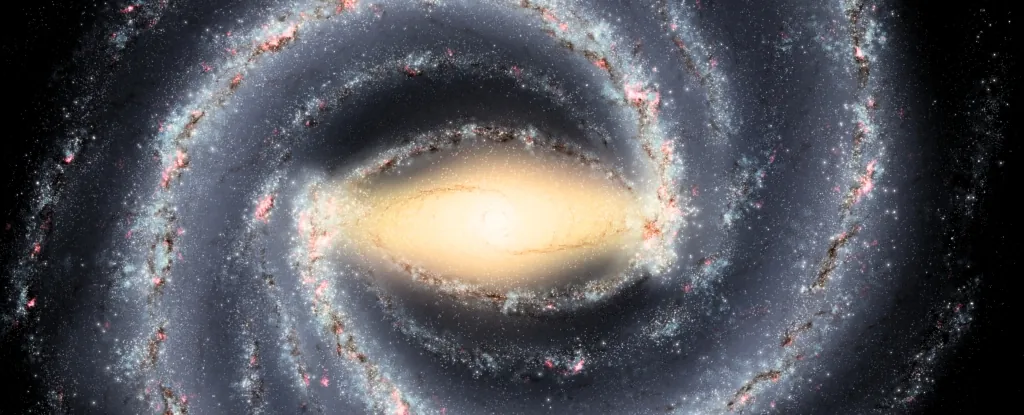
Unlocking Earth's Cosmic History: Are Galactic Forces Shaping Our Planet?
2025-09-22
Author: Rajesh
A Shocking Connection Between Earth and the Milky Way
When we think of Earth’s evolution, visions of volcanic eruptions and drifting continents often come to mind. Yet, a groundbreaking idea is suggesting that our planet's geological history might be intricately linked to the cosmos – specifically, the spiraling arms of the Milky Way galaxy.
Astrophysics Meets Geology
Recent research aims to bridge the gap between astrophysics and geology, proposing that the movement of our Solar System through the galaxy could directly influence Earth's geological activity. This unconventional theory, though previously limited by gaps in geological records, has gained traction from a fresh perspective that links maps of hydrogen gas in the Milky Way with the chemical compositions found in ancient Earth crystals.
The Power of Hydrogen
Astronomers utilize neutral hydrogen as a cosmic guide. This simple atom emits radio waves capable of penetrating the Milky Way’s dense dust and gas, revealing its sprawling spiral arms – structures that behave much like traffic jams of cosmic materials.
As our Solar System orbits the galaxy, it periodically intersects these arms every 180-200 million years, potentially increasing the chances of asteroid and comet impacts on Earth.
Zircon Crystals: Nature's Time Capsules
Could the evidence of these galactic encounters be stored in Earth’s geology? The answer may lie in zircon, a resilient mineral that forms in Earth’s crust, acting as a time capsule of geological conditions spanning billions of years.
These crystals can be dated and contain unique isotopes of oxygen, which serve as chemical markers of their origin, revealing whether they formed in African magma or interacted with surface waters.
Galactic Patterns Revealed Through Zircon
The latest study compares zircon isotopes with data on hydrogen density along our Solar System's orbit, revealing striking correlations. During periods when our Solar System passed through denser regions of hydrogen, the zircon isotopes exhibited significant variability.
This suggests a connection between periods of galactic influence and fluctuations in Earth’s crust formation, indicating that our planet has been influenced by these cosmic events.
The Oort Cloud and Cosmic Impacts
Why might these galactic encounters matter? As the Solar System traverses a spiral arm, it could disturb the Oort Cloud, an icy reservoir of comets residing beyond Pluto. Such disturbances could send comets hurtling towards Earth, their impacts delivering devastating energy that reshapes landscapes and creates geological imprints.
These moments of violence could create lasting records of Earth’s interactions with its galactic environment, preserved far longer than the fleeting impact craters we see today.
Understanding Earth in a Galactic Context
If Earth's geology is indeed influenced by the Milky Way, it enriches our understanding of planetary evolution, leading scientists to explore how galactic structures can reshape not just our world, but potentially influence life itself.
While it’s essential to remain cautious—correlation doesn’t imply causation—the compelling evidence connecting zircon crystals to galactic dynamics provides fascinating insights into the interconnectedness of the cosmos and our planet.
In this quest for knowledge, even the smallest grains of zircon may help us unveil the stories hidden within our Earth’s ancient past.



 Brasil (PT)
Brasil (PT)
 Canada (EN)
Canada (EN)
 Chile (ES)
Chile (ES)
 Česko (CS)
Česko (CS)
 대한민국 (KO)
대한민국 (KO)
 España (ES)
España (ES)
 France (FR)
France (FR)
 Hong Kong (EN)
Hong Kong (EN)
 Italia (IT)
Italia (IT)
 日本 (JA)
日本 (JA)
 Magyarország (HU)
Magyarország (HU)
 Norge (NO)
Norge (NO)
 Polska (PL)
Polska (PL)
 Schweiz (DE)
Schweiz (DE)
 Singapore (EN)
Singapore (EN)
 Sverige (SV)
Sverige (SV)
 Suomi (FI)
Suomi (FI)
 Türkiye (TR)
Türkiye (TR)
 الإمارات العربية المتحدة (AR)
الإمارات العربية المتحدة (AR)